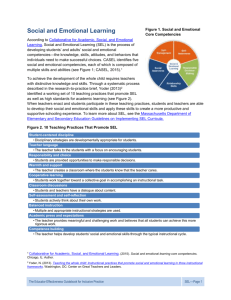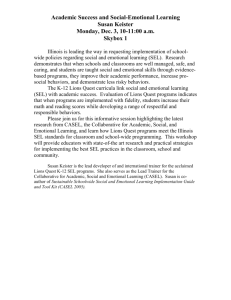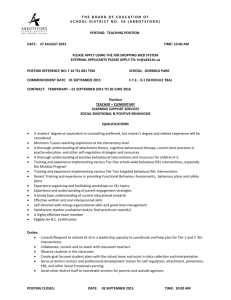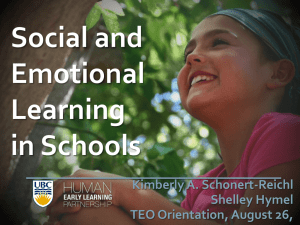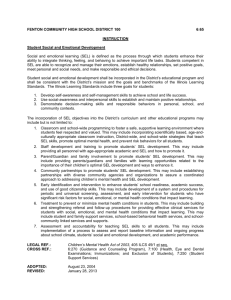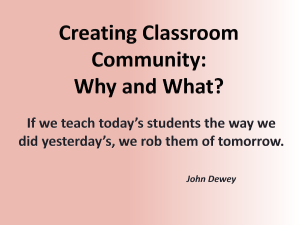Evaluating Effective Interventions for DIverse Students & Contexts
advertisement
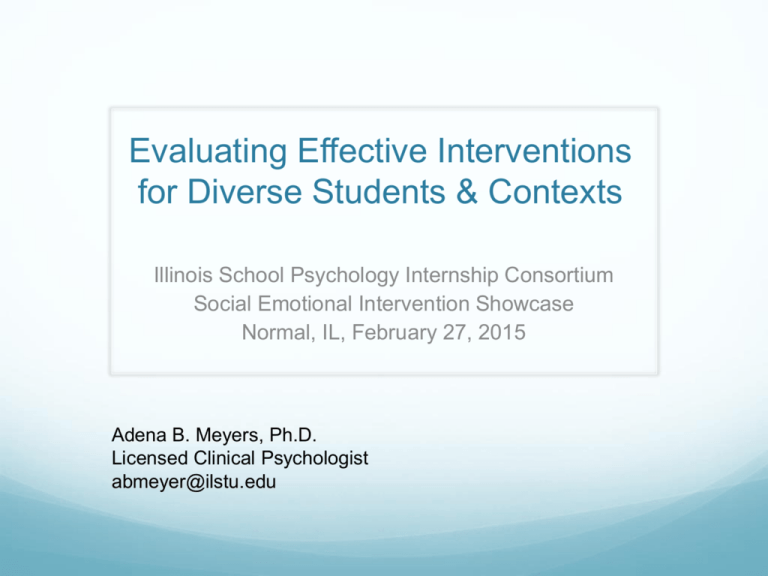
Evaluating Effective Interventions for Diverse Students & Contexts Illinois School Psychology Internship Consortium Social Emotional Intervention Showcase Normal, IL, February 27, 2015 Adena B. Meyers, Ph.D. Licensed Clinical Psychologist abmeyer@ilstu.edu Evaluating Effective ∧Interventions for Diverse Students & Contexts Illinois School Psychology Internship Consortium Social Emotional Intervention Showcase Normal, IL, February 27, 2015 Adena B. Meyers, Ph.D. Licensed Clinical Psychologist abmeyer@ilstu.edu Presenter Background Clinical/Community Psychologist Interest in School-Based Preventive Interventions Trainer of School Psychologists Mental Health Consultation in the Schools Supervision of Psychosocial Assessment & Intervention Practicum Researcher on School-Based Interventions Social and Emotional Learning (SEL) – CASEL Livingston County Children’s Network (LCCN) Evaluation Team Coauthor of Forthcoming Child Development Textbook Infants, Children, and Adolescents, 8th Edition (Berk & Meyers, 2015) Learning Objectives Three different functions of SEL evaluation: 1. How do researchers evaluate universal SEL interventions to find out if they work, for whom they work, and in which contexts they work? 2. How can school-based practitioners evaluate universal SEL interventions to decide which program to select for a specific population or setting? 3. After selecting and implementing universal SEL interventions, how can practitioners evaluate how well they are working in the local context? Presentation Outline Overview of SEL Definition Core Competencies & “SAFE” Procedures Theoretical Considerations: Person-Centered vs. System-Level Focus LO #1: How Researchers Evaluate SEL Programs Overview of Evaluation Research Methods Results and Characteristics of Previous SEL Evaluation Research LO #2: How to Select an SEL Program for your School Representativeness and Moderator Effects CASEL Guide & Other Sources Procedures for Selecting Programs LO #3: How to Determine if an SEL Program is Working Locally Implementation (Acceptability, Integrity) Formative Evaluation Summative Evaluation Part I Overview of SEL What is Social and Emotional Learning? SEL refers to explicit educational programming designed to foster development of children’s interpersonal skills, emotion management, and selfregulation (Greenberg et al., 2003) CASEL’s Core Competencies The Collaborative for Academic, Social, and Emotional Learning (CASEL, 2013) has identified five core SEL competencies in the areas of cognitive, affective, and behavioral functioning: What is SEL? S.A.F.E. Procedures Sequenced Active Focused Explicit SEL Programs… Are typically delivered in schools as universal interventions Are effective in improving students’ emotional, behavioral, and academic outcomes (Durlak et al., 2011– Meta-Analysis) Usually employ a mixture of “skills-focused” and “environment-focused” intervention methods (Christensen, 2011) Theoretical Considerations Person-Centered vs. System-Level Approaches to Primary Prevention Albee’s (1988) Primary Prevention Formula Risk Factors: Organic Factors; Stress; Systemic Exploitation Protective Factors: Self-Esteem; Competence; Social & Environmental Support A Multiscale View of Primary Prevention Systems-Level vs. Person-Centered Systems-Level Prevention Reduce: Organic Factors; Stress; Systemic Exploitation Increase: Self-Esteem; Competence; Social & Environmental Support Person-Centered Prevention Reduce: Organic Factors; Stress; Systemic Exploitation Increase: Self-Esteem; Competence; Social & Environmental Support Ecological View (Bronfenbrenner, 1977) Developmental Contexts Children’s Competencies Part II How do Researchers Evaluate SEL Programs? SEL Interventions Work! Durlak et al.’s (2011) meta-analysis synthesized results of hundreds of universal, school-based SEL evaluation studies. On average, SEL resulted in significant improvements in: SEL Skills Attitudes Towards Self and Others Positive Social Behavior Conduct Problems Emotional Distress Academic Outcomes Results were strongest for programs that followed S.A.F.E. guidelines, and for programs that were well implemented CASEL (2013) Guide SELect Programs Describes 23 SELect programs for preschool and elementary school students Can be downloaded for free (along with a plethora of other resources) at: http://www.casel.org/gui de CASEL SELect programs Are well-designed, multi-year, classroombased programs Target all five areas of SEL competence Provide opportunities for skill practice Offer training and other implementation support Are evidence-based Rating System to Determine if a Program is Evidence-Based CASEL SELect programs have at least one qualifying study meeting three review criteria: Between-groups design with pretest and posttest Demonstrated impact on qualifying outcome(s) Conduct Problems Positive Social Behavior Emotional Distress Academic Outcomes SEL Skill Performance Adequate internal validity (intervention caused the impact) Rating a Study’s Internal Validity A study was rated as qualifying if Its design was of reasonable quality such that findings were unlikely to be due to confounds or biases There was some confidence that the findings would be replicated if another party implemented the program A study was rated as not qualifying if A convergence of multiple study design factors were questionable in quality Potential confounds, biases, or alternative explanations indicated the study’s findings might be not reproduced if another party implemented the program and examined the same outcomes Results of Initial Stage Review Detailed Evaluation Review: General Results Detailed Evaluation Review: Reasons for Not Meeting Criteria Characteristics of SEL Evaluation Studies Meeting Criteria: Study Design Characteristics of SEL Evaluation Studies Meeting Criteria: Sample Size Number of Studies Characteristics of SEL Evaluation Studies Meeting Criteria: Statistical Analyses Findings of SEL Evaluation Studies Meeting Criteria Findings of SEL Evaluation Studies Meeting Criteria Findings of SEL Evaluation Studies Meeting Criteria Findings of SEL Evaluation Studies Meeting Criteria Conclusions: Characteristics of Excellent SEL Evaluation Research RCT with matching on pretest and demographic variables Inferential statistics with hierarchical modeling and appropriate covariates Measures with established/adequate psychometric properties Multiple and/or blind informants Assessment of treatment fidelity Published in high-impact peer-reviewed journals SEL Outcome Research Emphasizes Person-Centered Competencies Increased: Decreased: Academic Conduct Problems Performance Attitudes Towards Self and Others SEL Skills Positive Social Behaviors Emotional Distress How do SEL Programs Influence Systemic/Contextual Variables? Changes in teachers & teaching Changes in school or classroom climate Changes in teacher-student, teacher-parent, or student-student relationships Changes in environmental contingencies Interactive and mediating influences Three Models of Multiscale Dynamics in the SEL Literature 1. SEL Lessons + Teacher Training 2. Reciprocal Influence Among Attitudes, Behavior, and School Climate 3. Well-Implemented, Comprehensive, Multilevel Interventions 1. Skills-Focused Lessons + Teacher Training The Incredible Years Dinosaur School Curriculum (Webster-Stratton et al., 2008) Inputs Outputs Child Training: Skill Instruction, Modeling, Role-Play Children’s Emotion Regulation, School Readiness, Social Skills Teacher Training: Curriculum Delivery + Classroom Management + SEL Teaching Practices (Warmth, Consistency), Classroom Atmosphere, Parent-Teacher Relationships 1. Skills-Focused Lessons + Teacher Training 4Rs Curriculum (Brown et al., 2010; Jones et al., 2010; 2011) Inputs Child Training: Literacy-Based SEL Lessons + Skill Practice Teacher Training & Coaching: SEL Skills; Teacher-Student Interactions & Climate Outputs Children’s Hostile Attributions, Depression, & Aggression (); Prosocial Behavior () Improved Classroom Environment (Instructional Support & – marginally – Emotional Support) 2. Reciprocal Influence Among Attitudes, Behavior, & Context Steps to Respect Bully Prevention Program (Frey et al., 2005; 2009; Brown et al., 2011) Inputs Classroom Lessons: Beliefs about & Responses to Bullying, SEL Skills School Context: Teacher & Systemic Support ; Social Reinforcement of Bullying Outputs Children’s Problem Behaviors & Victimization Confidence Responding to Bullying; Attitudes and Bystander Behavior, School Climate Perceptions Ecological View (Bronfenbrenner, 1977) Developmental Contexts Children’s Competencies 2. Reciprocal Influence Among Attitudes, Behavior, & Climate Steps to Respect Bully Prevention Program (Frey et al., 2005; 2009; Brown et al., 2011) Inputs Classroom Lessons: Beliefs about & Responses to Bullying, SEL Skills School Context: Teacher & Systemic Support ; Social Reinforcement of Bullying Outputs Children’s Problem Behaviors & Victimization Confidence Responding to Bullying; Attitudes and Bystander Behavior, School Climate Perceptions 2. Reciprocal Influence Among Attitudes, Behavior, & Climate Steps to Respect Bully Prevention Program (Hirschstein et al., 2007) Inputs Classroom Lessons: Beliefs about & Responses to Bullying, SEL Skills School Context: Teacher & Systemic Support ; Social Reinforcement of Bullying Outputs Children’s Problem Behaviors & Victimization Confidence Responding to Bullying; Attitudes and Bystander Behavior, School Climate Perceptions 3. Improved Climate Mediates Effects of Systems Change on Child Outcomes Responsive Classroom (RC: Brock et al., 2008; Rimm-Kauffman & Sawyer, 2004; Rimm-Kaufman & Chiu, 2007; Rimm-Kaufman, et al., 2007; Sawyer & RimmKauffman, 2007) Caring School Community (CSC: Battistich et al., 1989; 2000; 2004; Solomon et al., 1988; 2000) Child Level: Formal SEL Skill Instruction Classroom Level: Teaching & Discipline Practices to Support SEL Development School Level: Family Involvement, Community Service Activities 3. Improved Climate Mediates Effects of Systems Change on Child Outcomes Inputs Classroom Lessons: SEL Instruction and Skill Practice (CSC) School Context: Teaching & Discipline Practices Conducive to SEL Development Outputs Improved Social Skills; Decreased Internalizing Symptoms Increased Teacher Collaboration; Improved Interpersonal Dynamics & Student Perceptions of Climate 3. Improved Climate Mediates Effects of Systems Change on Child Outcomes Input: Well-Implemented Comprehensive Multilevel Intervention Mediator: Perceptions of School or Classroom Climate Outcome: Social Skills, Interpersonal Behavior Conclusions about SEL and School Contexts Supportive contexts facilitate social and emotional development, and (with considerable investment of effort and resources) optimal contexts can be “engineered” Teachers appear to play a key role in SEL at both the child and classroom/contextual level Research is nascent (above conclusions are tentative) More research on environment-focused intervention elements and systems-level outcomes would help us understand the interplay between person-centered and systems-level variables Measurement of systems-level / contextual variables is tricky Part III How to Select an SEL Program for your School or District What works for whom? We know from Durlak’s metaanalysis and the CASEL guide that “SEL programs work” but how do you know which program might work best in your school with your students? Two Key Research Concepts Representativeness of the sample What were the characteristics of the schools, teachers, and students in the “qualifying studies” for a given program? How do these characteristics compare to your setting and students? Moderator effects By definition, universal interventions target all students, but some interventions may be especially effective with some subgroups of students or in schools with particular characteristics. Two Key Research Concepts Representativeness of the sample What were the characteristics of the schools, teachers, and students in the “qualifying studies” for a given program? How do these characteristics compare to your setting and students? Moderator effects By definition, universal interventions target all students, but some interventions may be especially effective with some subgroups of students or in schools with particular characteristics. CASEL Guide Provides Information on Representativeness in Tables CASEL Guide Provides Information on Representativeness in Tables CASEL Guide Provides Information on Representativeness in Tables A Caveat Our knowledge base is limited! Even if a program has been evaluated in a context similar to yours, it may not be the best choice (other programs may be a better fit in terms of cost, available training, targeted outcomes, or other considerations). If the student or school characteristics in the evaluation research do not match your local context, the intervention might still be a good choice (we don’t know that it won’t work). Two Key Research Concepts Representativeness of the sample What were the characteristics of the schools, teachers, and students in the “qualifying studies” for a given program? How do these characteristics compare to your setting and students? Moderator effects By definition, universal interventions target all students, but some interventions may be especially effective with some subgroups of students or in schools with particular characteristics. Moderator vs. Main Effects Most summaries of SEL evaluation research focus on main effects. These are the average effects across all participants in the study. Sometimes individual evaluations report moderator effects that demonstrate the program to be more effective for some subgroups of students than others, or in some schools than others. Read the individual study(ies) Examine at the program’s materials or website Ask the developer Examples of Moderator Effects in the Literature 4R’s program had a stronger effect on academic outcomes (academic skills and attendance) among students classified as high risk (based on aggression levels at baseline). For the Incredible Years program, several outcomes were more pronounced among students with higher levels of problem behaviors (such as off-task behavior and conduct problems) at baseline. Girls (but not boys) became more assertive after exposure to the Caring School Community intervention. Other Features of the CASEL guide Summarizes program features as well as evidence of effectiveness (Tables 1–4) Provides descriptions for all 23 SELect programs in appendix A Provides guidelines and recommendations for selecting programs CASEL website provides webinar on how to use the guide: https://www.youtube.com/watch?v=JiqkUpSebZk MANY Other Guides & Resources Also Available Blueprints for Healthy Youth Development (www.blueprintsprograms.com) SAMHSA’s National Registry of Evidenced-Based programs (NREPP) (www.nrepp.samhsa.gov) What Works Clearinghouse (ies.ed.gov/ncee/wwc/) Office of Juvenile Justice and Delinquency Prevention’s (OJJDP’s) Model Programs Guide (www.ojjdp.gov/mpg) Technical Assistance Center on Social and Emotional Intervention for Young Children (challengingbehavior.fmhi.usf.edu) Promising Practices Network (www.promisingpractices.net/programs.asp) Organizational Consultation Approach to SEL Selection (Meyers, Tobin, Huber, Conway, & Shelvin, 2015) Entry: Build relationships and communicate with stakeholders at all levels Problem Definition: With input from multiple stakeholders, define initial SEL-related targets (School climate? Risky behavior? Conduct problems? Teacher-student Relationships?) Needs Assessment: Systematically assess needs with input from all stakeholders, and share results with the stakeholders (report back results of interviews and surveys) Intervention: School-implementation advisory group (comprised of parents, teachers, & administrators) selected the intervention from an array of evidence-based programs (such as those on the SELect list) Evaluation: Ongoing – important to monitor how well the program is being implemented and how well it is working in the local context. Part IV How to Determine if an SEL Program is Working Locally Implementation Integrity Dosage (number and length of lessons) Procedural Integrity (inclusion of required elements) Quality (mastery practice) Contextual Adaptation (intentional changes) Acceptability Subjective views of the intervention among teachers, students, and other stakeholders “Readiness to Change” concept Formative Evaluation May focus on the implementation variables just described How many students are receiving the intervention? Are there any unintended consequences of the intervention (positive or negative)? Are changes needed to improve implementation? Summative Evaluation Was the intervention successful in the local context? Did outcomes improve? (Need to clearly define and monitor target outcome variables before, during, and after the intervention) Are improvements attributable to the intervention? (May need a comparison group to know for sure) Concluding Comments We know a lot about the effectiveness of universal SEL interventions When selecting interventions for diverse contexts and students, we cannot rely solely on previous research to guarantee success Implementation integrity includes contextual adaptation Local evaluation efforts are always needed
